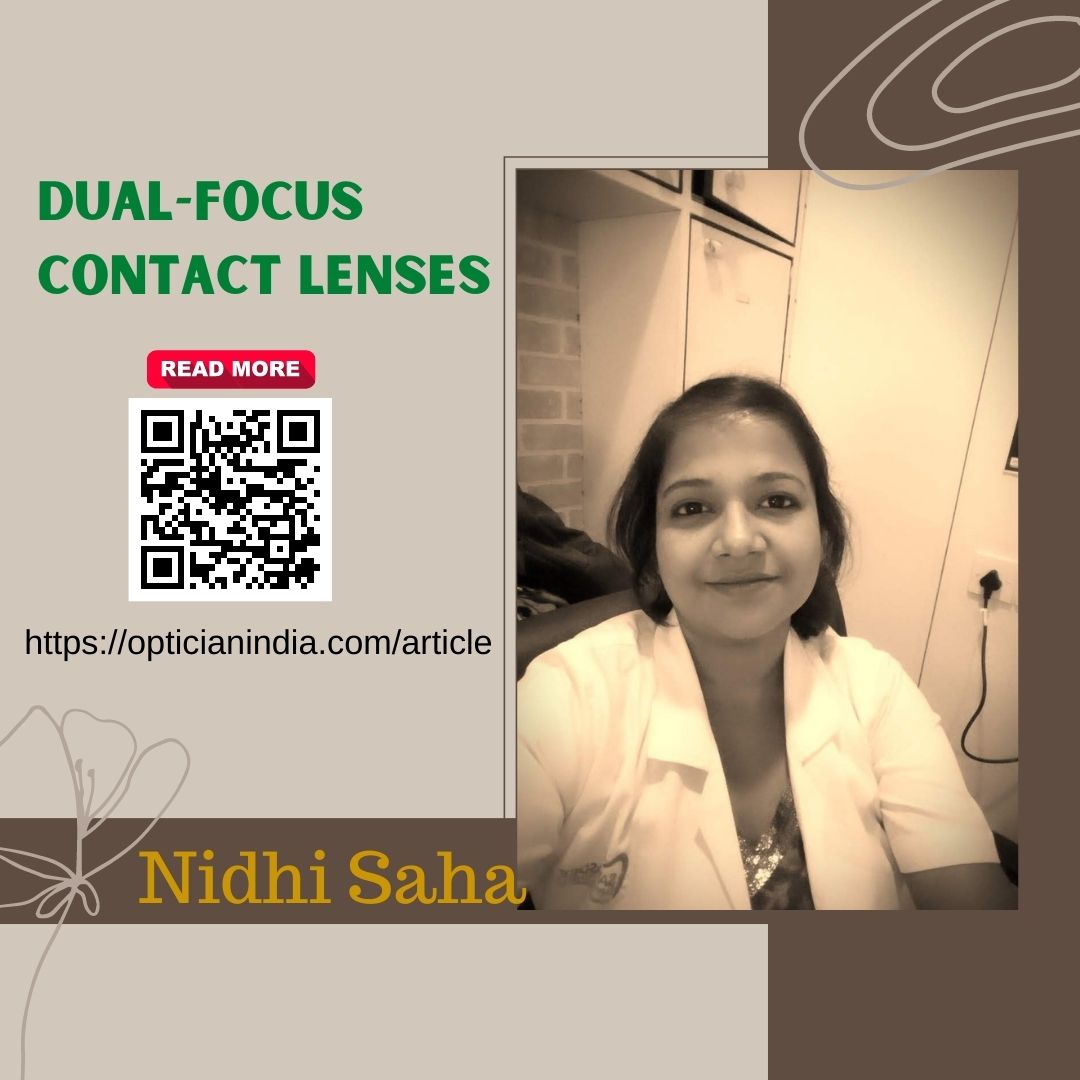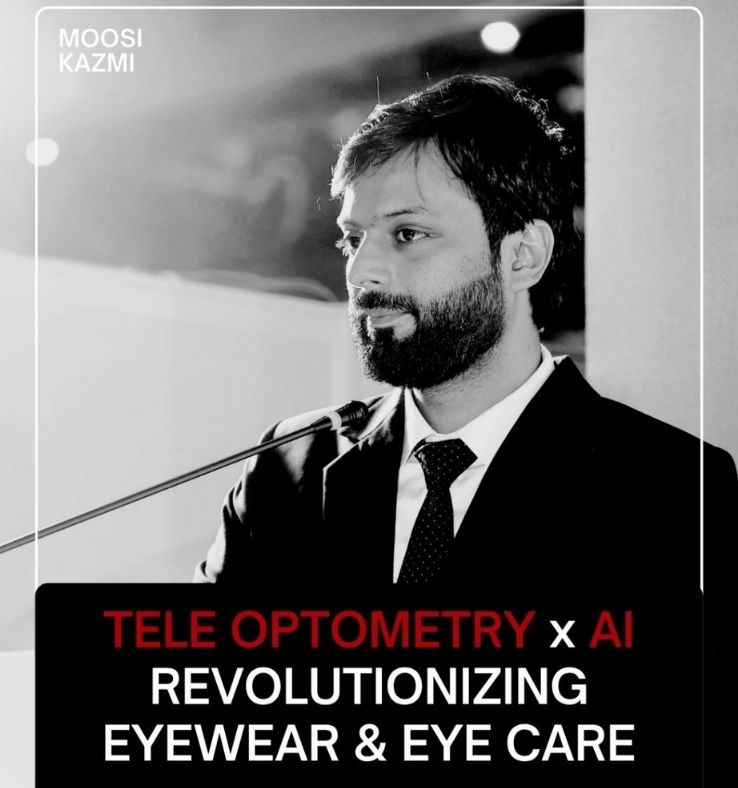Dual-focus Contact Lenses on Myopia Progression in Children

Introduction
Myopia or nearsightedness, is a potentially sight-threatening condition. Globally, nearly 30% of people live with myopia. Recently, myopia prevalence has been on the rise, especially among children. The increasing prevalence of myopia poses significant concerns relating to the quality of life of affected individuals.
Myopia Incidence is Projected to Rise
Estimates suggest that by the year 2050, the number of myopic individuals is expected to surge by a whopping 50%, and nearly 0.6% of the global population will suffer from myopia-related visual impairment – without appropriate management.(1) Thus, ongoing research actively explores various strategies to manage and impede myopia progression in children. One such promising approach is the use of dual-focus contact lenses.
Understanding Myopia Progression
Myopia occurs when the eyeball elongates, causing light to focus ahead of the retina. This results in blurred long-span vision. Of note, in individuals with myopia, near vision remains relatively unaffected. Although the susceptibility to retinal pathologies from eye growth prevails in later life, excess myopic eye growth is frequently encountered in early childhood and continues through adolescence(2). Complications of severe long-term myopic vision include – retinal detachment, glaucoma, and myopic maculopathy. Early intervention is therefore crucial to manage myopia progression during the formative years.
Modifying the visual environment (increased outdoor time; appropriate indoor lighting) and manipulating the visual optics to counteract changes in the external environment can aid in delaying myopia onset and curbing its progression(2).
Dual-Focus Contact Lenses
Dual-focus contact lenses are a relatively new approach to managing myopia progression in children. These lenses are designed with two different zones of power. The central portion (zone) of the lens corrects the refractive error for clear distance vision, while the peripheral zone focuses light in front of the retina to reduce the stimuli that promote eye elongation.
Thus, dual-focus contact lenses slow myopia progression and provide a clear retinal image by creating two focal planes. The concentric annuli of the lenses lead to myopic defocus on the peripheral and central retina. The central zone of the lens confers optimal refractive correction, whereas the concentric annuli lead to secondary refractive power; +2.00D compared to the central power, which in turn creates 2.00D of myopic defocus at the retinal plane(3). By simultaneously providing a clear vision for both distant and near objects, dual-focus contact lenses aim to slow down the axial elongation of the eyeball, which is the primary underlying cause of myopia progression.
Although the mechanism of defocus (central versus peripheral) in checking eye growth remains unclear, this innovative optical design allows for better peripheral defocus, which helps in controlling anatomical alterations of the eye and potentially reducing the myopia progression rate in children.
Evidence-Based Efficacy of Dual-Focus Contact Lenses
Many studies have evaluated the effect of dual-focus lenses on myopia progression in children. A study by Anstice et al.(4) in 2011 evaluated 40 children in a 20-month-long clinical trial. Here, a dual-focus contact lens was worn in one eye, whereas a single-vision distance contact lens was used in the other eye. The results demonstrated that dual-focus lenses allow for visual accommodation to nearby objects and significantly delay eye elongation and myopic progression. The data further suggested that a sustained myopic defocus can slow myopic progression without negatively impacting visual function.
A randomized controlled trial conducted by Walline et al.(5) in 2019 evaluated the use of dual-focus contact lenses in children aged 8-11 years. The results confirmed significantly reduced myopia progression in these children compared to those who used single-vision contact lenses.
It is hypothesized that less time spent in outdoor activities and increased time for work-related engagements heighten myopia prevalence. A retrospective study conducted during the coronavirus disease 2019 (COVID-19) pandemic included 22 children suffering from myopia (11 wearing dual-focus soft contact lenses and 11 wearing spectacles). The study compared the axial length changes together with the refractive changes amongst children of both groups; the average outdoor time was restricted in both cohorts. The findings depicted that despite the hybrid learning methods adopted during the lockdown, the dual-focus contact lenses proved to be more effective in controlling myopia progression. Further, the results of a 2022 study disclosed that limiting outdoor time did not impact the benefits of dual-focus contact lenses in the myopic eye. Nevertheless, the efficacy of these lenses in checking myopia progression was affected by patient compliance with lens wear.(6)
Another 2019 study by Sankaridurg et al.(7) recorded data from children between 7-14 years – for three years. The researchers found that wearing dual-focus contact lenses resulted in a 30% reduction in the progression of axial length alterations annually, compared to the control group. These findings provide strong evidence for the efficacy of dual-focus contact lenses in managing myopia progression.
It is known that hyperopic defocus accelerates eye growth in children. Conversely myopic defocus slows eye growth and even counteracts the growth signal present simultaneously due to hyperopic defocus. A study abstract presented at the ARVO Annual Meeting in Denver in 2022, examined the impact of dual-focus lenses among children during near viewing. The study was performed on a cohort comprising 17 myopic teenagers who were being treated with dual-focus lens over the last 3-6 years. The results revealed that the dual-focus lenses reduced the percentage of hyperopic defocus in the image on the fovea from 50% to 28% thereby increasing the myopic defocus from 18% to 40%. Hence, the +2D myopic defocus successfully removed the hyperopic defocus while introducing myopic defocus in the image on the fovea. The findings confirmed the hypothesis that dual-focus lenses control myopia by the extra myopic defocus.(8)
A recent multicenter trial conducted over six years by Chamberlain et al.(2) assessed the effect of dual-focus contact lenses on myopia progression in children (8-12 years). Here, children who switched to dual-focus contact lenses by the end of the third year of treatment were also evaluated. The results confirmed the effectiveness of dual-focus contact lenses in slowing myopia progression, thereby pointing toward the cumulative treatment effect. It was also found that the cohort who used dual-focus contact lenses over the three-year treatment period sustained a slower rate of eye elongation – by 71%.
Delaying myopic progression holds equal importance as sustaining the results post-treatment. A study by Hammond et al.(9) aimed to quantify age-related eye growth following the withdrawal of dual-focus contact lenses. It was inferred that early commencement of myopia treatment and continuing such treatment throughout adolescence maximizes the myopia control benefit.
Further studies are warranted to assess the efficacy of optic behavior among children in predicting the success of dual-focus lenses to control myopia.
Conclusion
Dual-focus contact lenses offer a promising approach to address the growing concern of myopia progression in children. By providing clear vision at both near and distant, these lenses promise to slow down eye elongation and potentially reduce the myopia progression rate. As with any vision correction method, it is crucial to consult an ophthalmologist or an eye care professional to determine the suitability and prescription of dual-focus contact lenses for individual cases. With ongoing research and advancements in optical technology, dual-focus contact lenses hold great potential in shaping the future of myopia management in children.
References
-
Turnbull PR, Goodman LK, Phillips JR. Dual?focus contact lenses for myopia control modify central retinal electrophysiology in humans. Ophthalmic and Physiological Optics. 2023 May 15.
-
Chamberlain P, Bradley A, Arumugam B, Hammond D, McNally J, Logan NS, Jones D, Ngo C, Peixoto-de-Matos SC, Hunt C, Young G. Long-term effect of dual-focus contact lenses on myopia progression in children: A 6-year multicenter clinical trial. Optometry and Vision Science. 2022 Mar 1;99(3):204-12.
-
Walline JJ, Walker MK, Mutti DO, Jones-Jordan LA, Sinnott LT, Giannoni AG, Bickle KM, Schulle KL, Nixon A, Pierce GE, Berntsen DA. Effect of high add power, medium add power, or single-vision contact lenses on myopia progression in children: the BLINK randomized clinical trial. Jama. 2020 Aug 11;324(6):571-80.
-
Anstice NS, Phillips JR. Effect of dual-focus soft contact lens wear on axial myopia progression in children. Ophthalmology. 2011 Jun 1;118(6):1152-61.
-
Walline JJ, Greiner KL, McVey ME, Jones-Jordan LA. Multifocal contact lens myopia control. Optometry and Vision Science. 2013 Nov 1;90(11):1207-14.
-
Cabanes?Martí E, García?Ayuso D. Myopia control with dual?focus soft contact lenses during the first year of measures to contain the COVID?19 pandemic. Ophthalmic and Physiological Optics. 2022 Nov;42(6):1227-31.
-
Sankaridurg P, Holden B, Smith E, Naduvilath T, Chen X, de la Jara PL, Martinez A, Kwan J, Ho A, Frick K, Ge J. Decrease in rate of myopia progression with a contact lens designed to reduce relative peripheral hyperopia: one-year results. Investigative ophthalmology & visual science. 2011 Dec 1;52(13):9362-7.
-
Meyer D, Ramasubramanian V, Logan NS, Jones S, Jaskulski M, Rickert M, Bradley A, Arumugam B, Chamberlain P, Kollbaum PS. Dual Focus Contact Lenses induce Myopic Defocus in Children during Near Viewing. Investigative Ophthalmology & Visual Science. 2022 Jun 1;63(7):1437-F0395.
-
Hammond DS, Arumugam B, Bradley A, Nguyen M, Chamberlain P. Prior myopia control effects retained upon cessation of dual-focus soft contact lens wear. Investigative Ophthalmology & Visual Science. 2022 Jun 1;63(7):245-A0099.

.jpg)

.jpg)
.jpg)
.jpg)


1.jpg)



.jpg)
.jpg)



_(Instagram_Post).jpg)
.jpg)
_(1080_x_1080_px).jpg)


with_UP_Cabinet_Minister_Sh_Nand_Gopal_Gupta_at_OpticsFair_demonstrating_Refraction.jpg)
with_UP_Cabinet_Minister_Sh_Nand_Gopal_Gupta_at_OpticsFair_demonstrating_Refraction_(1).jpg)

.jpg)








.jpg)



.png)




